Meet the Inklings: The Literary Fellowship of C. S. Lewis and J. R. R. Tolkien
The Inklings were a group of Oxford professors and residents who met in the 1930s and 40s to discuss literature, philosophy, and culture. Bibliophiles know the group for its two most famous members, C. S. Lewis and J. R. R. Tolkien. Together, the Inklings changed the way we think about imagination and religion in the 20th century and beyond.
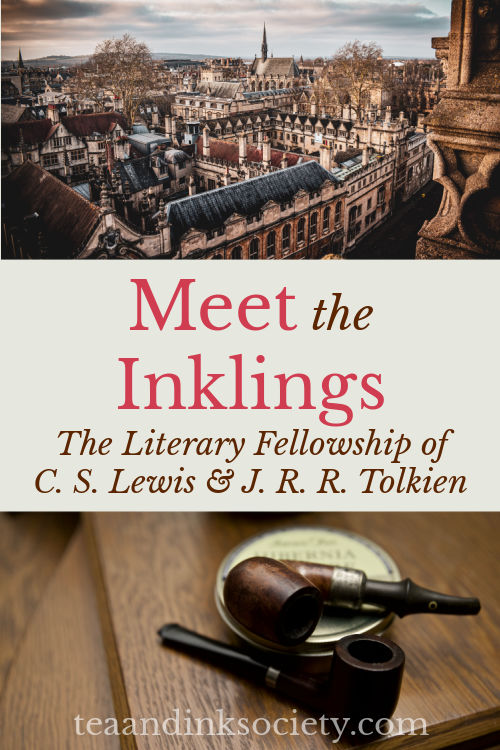
As I write this, it’s September and at last we’re getting the first delicious stirrings of fall. (I kept my windows open last night!) In the spirit of fall and all the back-to-school associations that brings, today’s post is an introduction to an academic group of literature enthusiasts who met in the most quintessential scholarly setting in the world: Oxford University. Not Yale, not Harvard, not Ca– well, you get the point, it’s clear I have my favourite!
The group called themselves “the Inklings.”
Active in the 1930s-40s, the Inklings met regularly for fellowship and to discuss their latest compositions. Although plenty of scholarly groups like this existed in Oxford and Cambridge and other university towns, the Inklings is remembered because among its members were two of the most famous authors of the twentieth century: J. R. R. Tolkien and C. S. Lewis.
If you know even a little about the authors J. R. R. Tolkien and C. S. Lewis, you’ll know that they knew each other–perhaps even that they were friends for most of their adult lives. This friendship was crucial to their writings, and it’s incredible to think that without it, Lewis’s books would’ve been wholly different; Tolkien’s might not be published at all!
Tolkien wrote that “The unpayable debt that I owe to [C. S. Lewis] was not ‘influence’ as it is ordinarily understood, but sheer encouragement. He was for long my only audience. Only from him did I ever get the idea that my ‘stuff’ could be more than a private hobby. But for his interest and unceasing eagerness for more I should never have brought The L. of the R. to a conclusion.”
By “The L. of the R.” he means The Lord of the Rings, of course. Can you imagine? Can you imagine not having these books, and their influence on popular culture and literally every fantasy novel published since? I’m not sure we can!
For many of us fans, the roots of our love for Tolkien’s world go deep. There was already a Tolkien Society begun in Tolkien’s lifetime, and the books exploded in popularity with college students and young adults during the counter-culture of the mid ’60s and ’70s. When those fans (among them my dad) grew up, they read Tolkien’s books to their kids (among them, me). We were the lucky ones who got to watch those stories of our childhood come to life with Peter Jackson’s film trilogy. And now, as hopefully a new generation of Tolkien fans emerges, we have The Rings of Power series.
Similarly, Lewis’s Chronicles of Narnia series is part of the fabric of our childhood imaginations. They made us realise literature’s power to move us deeply–to feel heroism, suspense, longing, even virtues like prudence and temperance (would I have known to leave the wardrobe door open? Would I have gorged myself on Turkish delight? Struck the bell on Charn?).
The Tolkien-Lewis friendship predated the unofficial “official” Inklings group. Both professors at Oxford, they already met often for conversation, and adopted the Inklings moniker after a university group of the same name disbanded in 1933. Increasingly, they began inviting other colleagues to join them, and soon had regular gatherings.
If you could time travel back to Oxford in the 1930s on a Tuesday morning (almost any Tuesday will do), and make your way to St. Giles’ Street, it’s very likely you’d see Lewis, Tolkien, and several of their friends enter the Eagle and Child pub. You’d see them head straight to a back room, closed off from the rest of the pub, where they’d lunch, drink beer, and enjoy the type of hearty or mundane conversation that happens in the current of a busy, typical day.
The real “business,” so to speak, happened on Thursday nights after the day’s business was done, when the group could linger late into the night, deep in discussion or listening to each other’s scribblings–scribblings that would later become their lectures, published poems, novels, radio broadcasts, or plays.
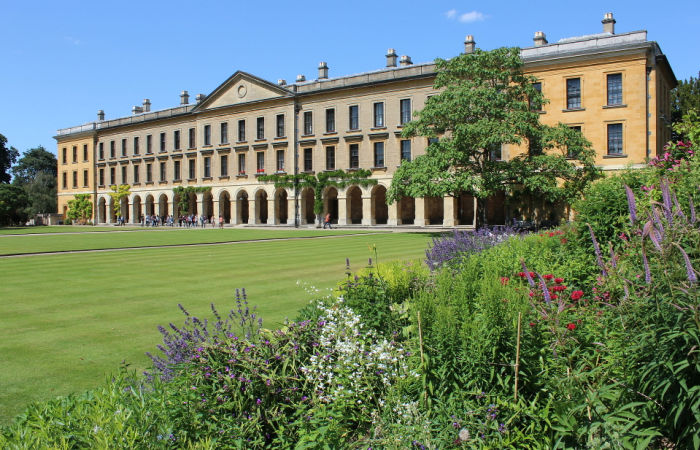
For these Thursday meetings the Inklings met in C. S. Lewis’s rooms at Magdalen College. Lewis had a house outside of Oxford, but as a university professor he had private rooms within his college where he could work and conduct tutorials with students. There were couches and chairs, and a fireplace to keep things cozy on frosty nights, and many of the men would light pipes as they settled in.
Let’s take a look round the room and see who might’ve been there…
Inklings Members (Besides Tolkien and Lewis)
J. R. R. Tolkien and C. S. Lewis are the most well-known of the Inklings, but about twenty additional participants came and went over the years. The numbers were fluid, and World War II shuffled things up as some members left Oxford and others arrived. A typical Thursday gathering could see anywhere from three to seven men, sometimes more.
2022 Classics Reading Challenge
If you’re following along with our 2022 Classics Reading Challenge (and it’s never too late to join!), the theme for September is “a book by an Inkling.” I hope this will post will help you discover some of the books they wrote!
Owen Barfield
Owen Barfield met C. S. Lewis when the two were undergraduates at Oxford and they remained close friends for over four decades, until Lewis’s death. One of the customs they maintained throughout the years was to take long, rambling walking tours around the English countryside during school holidays, sometimes joined by Tolkien or other friends. (If you’ll recall, Lewis’s novel Out of the Silent Planet begins with the protagonist taking a walking tour.)
Barfield had a tremendous influence on both Lewis and Tolkien in their conversations about the significance of imagination, truth, myth, the history of language, and other themes that would recur throughout their writings. Lewis said that Barfield helped cure him of “chronological snobbery”; the assumption that past ages are inferior for lack of our modern answers. I doubt Lewis ever would’ve written a fantasy series if it hadn’t been for Owen Barfield.
Barfield’s own fantasy story, a children’s book called The Silver Trumpet, was praised by Lewis, and it “scored a direct hit” when Tolkien read it aloud to his kids. If you ever see a copy at the thrift store snag it, because the paperback is $48 online! Thankfully, the text is also available to read online for free. Later, Lewis wrote his first fantasy novel, The Lion, the Witch, and the Wardrobe for Barfield’s daughter Lucy, and dedicated The Voyage of the Dawn Treader to Barfield’s son Jeffrey.
Barfield was a prolific writer, authoring poems, philosophy books, literary criticism, and plays, as well as numerous essays and editorials. You can find a comprehensive bibliography here. Notable works include Poetic Diction, a study of poetry as a way to understand human thought; the philosophy book Saving the Appearances; and History in English Words, which explores the history of Western civilization through etymology. Several more of his works are available here.
Charles Williams
Charles Williams joined the Inklings when his employer, the Oxford University Press, relocated from London to Oxford to avoid bombing during World War II. Williams and C. S. Lewis had already exchanged letters of mutual admiration for each other’s work, and Lewis was only too happy to invite him into the group. Tolkien, on the other hand, while he enjoyed Williams’s company, remarked later that they “had nothing to say to one another at deeper (or higher) levels” and that their minds were “poles apart.”
Besides Lewis and Tolkien, Williams was the other major novelist of the Inklings group, publishing seven novels–the last of which, All Hallows Eve, was written and read aloud during his time with the Inklings. Williams’s novels are metaphysical thrillers that blend Christianity with occult themes and symbolism, and take place in modern England rather than an invented fantasy world. (The final book in Lewis’s Space Trilogy, That Hideous Strength, is certainly influenced by Williams’s style.)
In addition to novels, Williams wrote plays, biographies, literary criticism, theology, and poetry. He considered his most important work to be his complex Arthurian poetry cycles Taliessin Through Logres, and The Region of the Summer Stars. His book on Dante inspired Dorothy L. Sayers to leave off writing detective novels in order to translate The Divine Comedy. (Not sure if Peter Wimsey fans can thank him for that.)
You can read the novels of Charles Williams online for free.
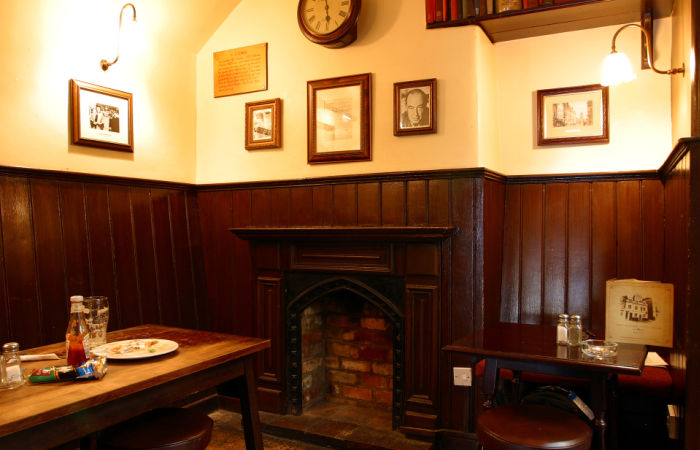
Warren “Warnie” Lewis
Older brother to C. S. Lewis, Warren was one of the few Inklings who was not an Oxford don. Although both Jack and Warren fought in World War I, Warren continued his military career after the war, serving in postings around the world and coming out of retirement to serve in World War II (he was one of the soldiers evacuated at Dunkirk).
Warren also had a literary bent: after his second retirement from the military, he pursued his lifelong interest in 17th century French history, and went on to publish seven popular books on French life and court intrigue! The easiest to find of his books is The Splendid Century: Some Aspects of French Life in the Reign of Louis XIV. And here is a list of his works, if you’d like to hunt down the others (although one is misattributed–I’ll let you guess which!)
Dr. Robert Havard
Dr U.Q. Humphrey
– J. R. R. Tolkien
Made poultices of comfrey
If you didn’t pay his bills
He gave you doses of squills
A medical doctor who attended Lewis (and later Lewis’s wife, Joy Gresham), Lewis invited him to come to the Inklings meetings because of Havard’s interest in literature. Harvard became one of the most faithful attendees of the Inklings, and garnered the most nicknames including “Humphrey,” “Useless Quack” (or simply “U. Q.”, and “The Red Admiral.” He later became neighbors with the Tolkien family and attended the Catholic church with them. Lewis’s book Prince Caspian is dedicated to Havard’s daughter.
Hugo Dyson
Hugo Dyson was an English literature professor who specialized in Shakespeare, Neoclassical authors, and the Romantics. Known as the most colorful of the Inklings, Dyson was voluble and witty, always preferring conversation at the Inklings meetings over listening to compositions. During one meeting, at the prospect of hearing from The Lord of the Rings, Christopher Tolkien recalls Dyson “lying on the couch, and lolling and shouting and saying, “Oh God, no more elves.'” (Except that others have reported Dyson’s language was a bit stronger!)
Warren Lewis described Dyson as “being made of quick silver,” and after one particularly lively meeting, C. S. Lewis called him a “roaring cataract of nonsense.” But one thing Dyson took seriously was his deeply-held faith. Along with Tolkien, Dyson was instrumental in converting C. S. Lewis to Christianity. They had many conversations on spiritual matters, including a memorable late-night talk in Addison’s Walk that Lewis credited for moving him to believe not just in God, but in Christ and Christianity. If you’re not a fan of Lewis this won’t mean much, if you are, it’s providential: Lewis was the greatest Christian apologist of the twentieth century, and without his faith the Narnia chronicles couldn’t have been written.
Lord David Cecil
In contrast to Hugo Dyson, Cecil was one of the more soft-spoken men of the group. He had plenty of intelligent things to say, however, and was known around Oxford for his excellent lectures. He already had a title, but he made a name for himself as a literary historian and biographer, publishing biographies of Jane Austen, Thomas Hardy, William Cowper, Sir Walter Scott, and others. His two-part biography on Lord Melbourne, mentor and Prime Minister to Queen Victoria, has received a resurgence in popularity after the recent BBC miniseries series Victoria. Secondhand copies of many of his books are available here.
Nevill Coghill
Mr. Neville Judson Coghill
– J. R. R. Tolkien
Wrote a deal of dangerous doggerill.
Practical, progressive men
Called him Little Poison-pen
An Irishman like the Lewis brothers, Coghill specialized in drama, serving as director and producer in the Oxford University Dramatic Society. During his career he directed Richard Burton and Elizabeth Taylor, and co-wrote several plays including the pageant The Masque of Hope in honor of Princess Elizabeth’s visit to Oxford in 1948, and the West End and Broadway musical Canterbury Tales.
Nevill Coghill is widely known for his modern English translation of The Canterbury Tales. If you have a copy on your bookshelf, go check it right now…it’s highly likely you’ll see Coghill’s name on the back cover or title page!
Adam Fox
The oldest member of the Inklings, Adam Fox was Dean of Divinity at Magdalen College and served as the Oxford Professor of Poetry from 1938 to 1942, a position which he obtained largely due to the advocacy of Lewis and Tolkien. Later he served as Canon of Westminster Abbey in London, and he is buried there in the Poet’s Corner. Fox had several publications, including the long poem Old King Coel, and Plato for Pleasure, a biography and literary analysis of the philosopher.
Jack A. W. Bennett
Bennett was the youngest Inklings member and the only New Zealander. Bennett specialized in Middle English literature, lecturing and editing volumes on Chaucer and Malory. He was elected Professor of Medieval and Renaissance English at Cambridge University after C. S. Lewis retired from the position in 1963.
Christopher Tolkien
Son of J. R. R. Tolkien, Christopher Tolkien began attending Inklings meetings at his father’s invitation when he was twenty-one. Christopher Tolkien had grown up hearing his father’s tales of Middle Earth, and he was often the one to read aloud sections of The Lord of the Rings during gatherings of the Inklings.
After J. R. R. Tolkien’s death, Christopher Tolkien acted as his father’s literary executor, editing and publishing over a dozen volumes related to the Middle Earth mythos, as well as his father’s translations and commentaries on Medieval texts like Beowulf and Sir Gawain and the Green Knight. Here is a complete list of Christopher Tolkien’s published works.
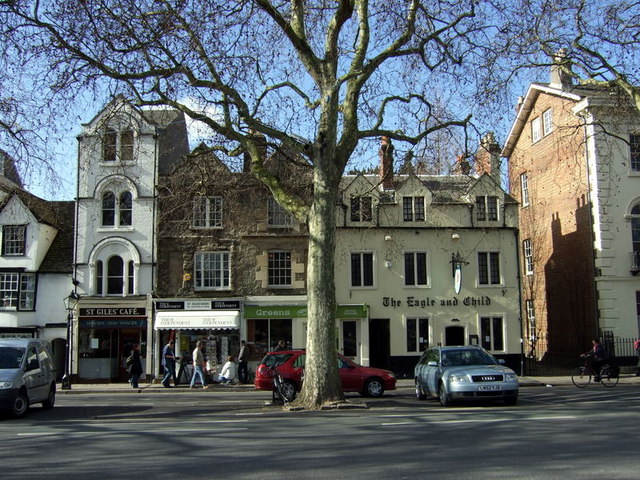
Other Inklings Members and Occasional Guests
There are a number of other men who attended the Inklings at one time or another. I will add their biographies here as I’m able! Meanwhile, in bullet form:
- Colin Hardie (Lewis’s The Silver Chair is dedicated to his son Nicholas)
- Fr. Gervase Matthew
- Charles Leslie Wrenn
- C. E. Stevens
- James Dundas-Grant
- R. B. McCallum
- Percy Bates
- Walter Hooper
- John Walsh
- Martin Gilbert
- John David Arnett
- Jon Fromke
- E. R. Eddison (author of the fantasy novels The Worm Ouroboros and the Zimiamvia trilogy)
- Roy Campbell
- John Wain (although he attended some Inklings meetings, Wain didn’t identify himself as part of the group)
Was Dorothy L. Sayers an Inkling?
The Inklings was a boys’ club, and Dorothy L. Sayers wasn’t in it. Nor were any other women. Sayers wasn’t actually living in Oxford when the Inklings were active. However, as an Oxford alumna and friend of several Inklings members, her name has often been associated with the group. For the purposes of our Classics Reading Challenge, you can consider Sayers an “honorary Inkling” and read one of her books for this month’s theme, if you like!
At some point, I will do a complete post just on Sayers, but in the meantime you can find a list of her works here.

Works by Clive Staples Lewis (“Jack”)
Lewis published numerous books during his lifetime, and after his death many more books were published compiling his essays, lectures, poems, and letters. Here’s a sampling of some of his most famous works, along with books I think Tea and Ink readers would be interested in. (For a more extensive bibliography, go here.) Eight of his popular books are collected in this set.
Fiction
- The Pilgrim’s Regress – A modern retelling of Bunyan’s Pilgrim’s Progress.
- The Space Trilogy (Out of the Silent Planet, Perelandra, and That Hideous Strength)
- The Chronicles of Narnia series (7 books)
- The Screwtape Letters – A collection of “letters” written by a senior demon to his mentee.
- The Great Divorce – An allegorical novella about Heaven and Hell.
- Till We Have Faces – A novel retelling of the Cupid and Psyche myth. (Mentioned in my Book Oscars post.)
- The Dark Tower and Other Stories – A posthumously-published collection of Lewis’s short stories and unfinished fiction.
Selected Nonfiction
At first glance, some of C. S. Lewis’s more theological books seem too specific to interest people who don’t share his religious convictions. But, I’d encourage anyone in this camp to give them a try anyway! You’ll be in good company with a wide readership of all beliefs who have found Lewis’s books to be thought provoking and eye-opening.
- The Problem of Pain – A theodicy that explores how suffering can exist in light of an all-powerful, good God.
- The Abolition of Man – Lewis’s influential treatise on education, morality, and Western culture.
- Miracles – A philosophical apologetic for the miraculous.
- Mere Christianity – An apologetic for the Christian faith, based on Lewis’s famous radio broadcasts during World War II.
- The Four Loves – An exploration of four types of human love and their significance for interpersonal relationships.
- Surprised By Joy – Memoir about Lewis’s early life and road to conversion.
- A Grief Observed – Lewis’s memoir and exploration of loss after the death of his wife.
- On Stories – A collection of several of Lewis’s essays on fiction and stories.
- An Experiment in Criticism – A “book about books,” perfect for bookworms who want to contemplate the literary experience.
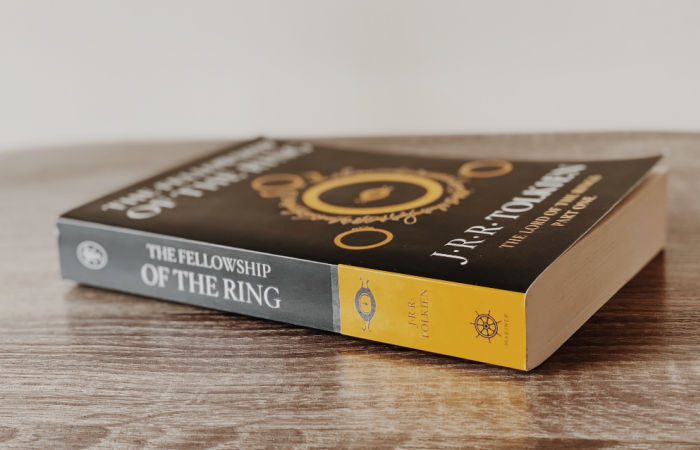
Works by John Ronald Reuel Tolkien
Tolkien’s hobby was writing about his invented world of Middle Earth, developing its history and languages and creating Middle Earth’s visual aesthetic with his drawings and paintings. However, the only Middle Earth books published during his lifetime were The Hobbit and The Lord of the Rings. After his death, Christopher Tolkien took on the massive endeavor of editing and compiling his father’s unfinished and unpublished works. (Find an extensive J. R. R. Tolkien bibliography here.)
Selected Works
- The Hobbit
- The Lord of the Rings (The Fellowship of the Ring, The Two Towers, and The Return of the King)
- The Silmarillion – A posthumously-published volume in the Middle Earth legendarium.
- The History of Middle Earth – 12-volume series compiled and edited by Christopher Tolkien from his father’s manuscripts and notes.
- Letters from Father Christmas – Posthumously-published collection of letters that Tolkien originally wrote for his children.
- Roverandom – A posthumously-published children’s fantasy novel that that Tolkien wrote and illustrated for his children.
- Smith of Wootton Major and Farmer Giles of Ham – Two fantasy short stories.
- Tree and Leaf – A collection that includes Tolkien’s famous “On Fairy-Stories” lecture, the short story “Leaf by Niggle,” the poem “Mythopoeia,” and the verse drama “The Homecoming of Beorhtnoth.”
- Letters of J. R. R. Tolkien – Collection of Tolkien’s personal letters, providing a fascinating insight into his life and creative process.
- The Monsters and the Critics – A hard-to-find but worthwhile collection of essays.
Books About the Inklings
- The Inklings by Humphrey Carpenter – Carpenter was acquainted with Tolkien and Dyson.
- The Company They Keep by Diana Pavlac Glyer – An academically-aimed group biography of the Inklings.
- Bandersnatch by Diana Pavlac Glyer – Written for a more general audience than Company.
- The Fellowship: The Literary Lives of the Inklings by Philip Zalesky and Carol Zalesky
What else do you know about the Inklings? Which books by Inklings have you already read, and what’s on your want-to-read list?
Other posts in the “Authors You Should Know” series


I didn’t realize Walter Hooper was considered an Inkling. He edited and published all of CS Lewis’s letters, and reading them has been one of my greatest joys. He responded to everyone who wrote to him. What a great gift!
I would love to read Lewis’s letters some time! How neat that he actually cared that much about his readers! And it looks like Hooper wouldn’t have been at any of the original Inklings meetings. Possibly Eagle & Child gatherings at the end of things, since they kept gathering at the pub for some years after the Thursday night meetings fizzled. I’ll have to do some more research on that and update the post!
I’m already “reading” (on audio) “The Return of the King” – the third of the three “Lord of the Rings” books. It’s my favorite fantasy series!
Ah, that’s great!! My husband has listened to the Rob Inglis narrated versions so many times! I ought to do that to get another re-read in, since it is a big time commitment to do a sit-down read. How do you think the Jackson film trilogy did with the source material? Are you a fan of the movies too?
Ah, I love the Inklings! Thank you for sharing more on the lesser-known ones, too! I have Diana Glyer’s BANDERSNATCH on my TBR, as I’m curious to learn more about how this group influenced and encouraged one another.
You’re welcome! Yes, it’s pretty neat to think about what good things can happen in community, as evidenced here!